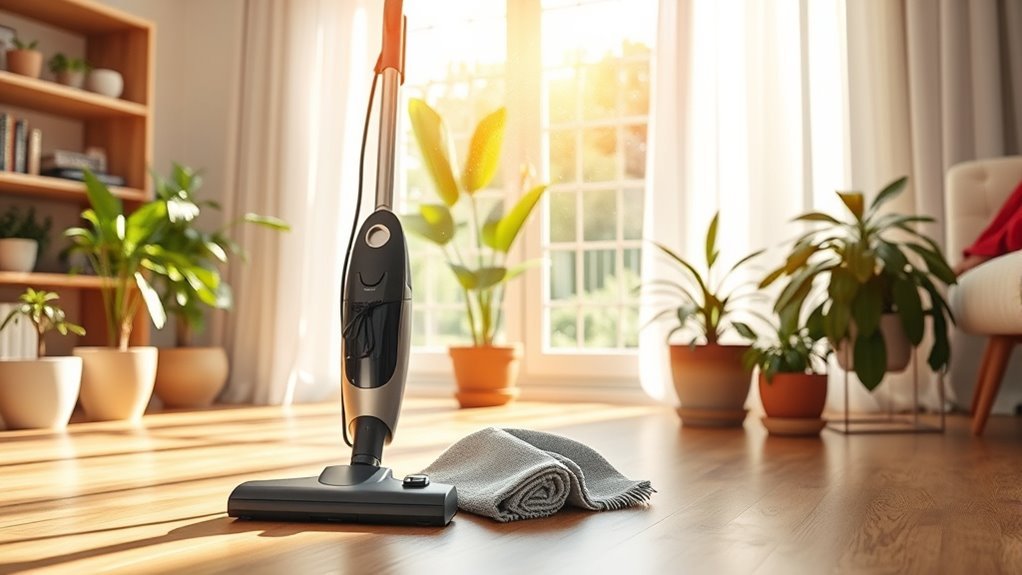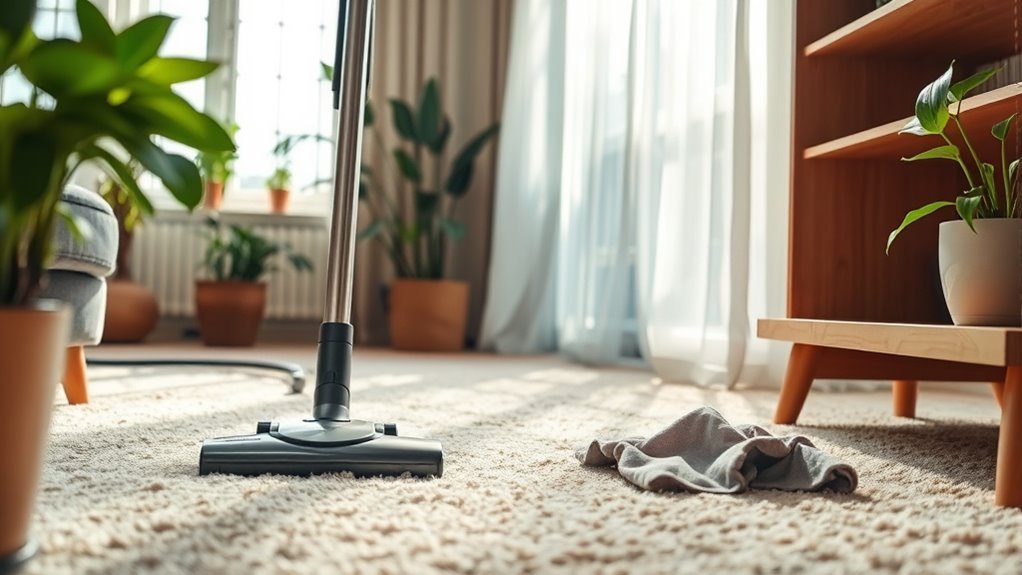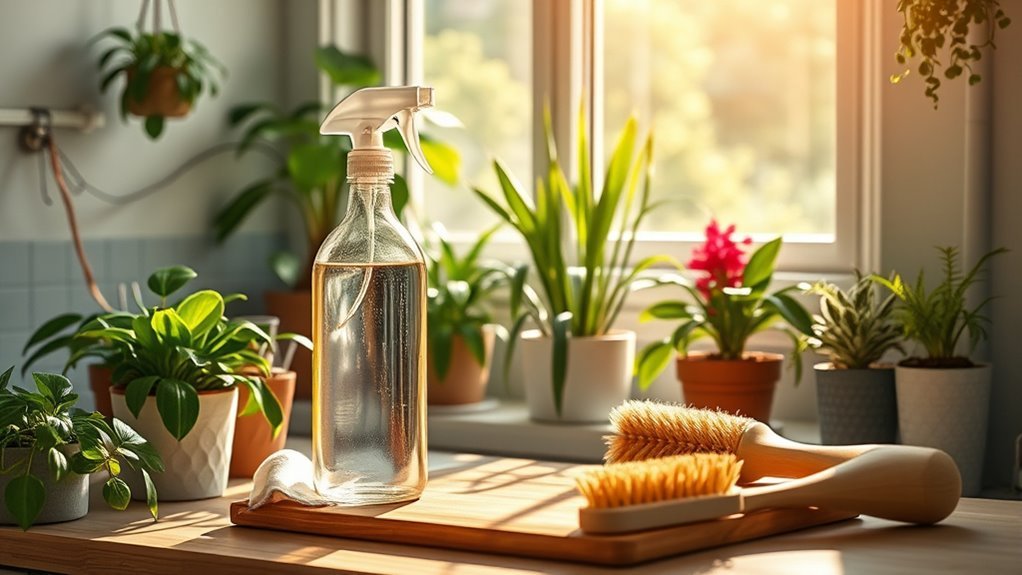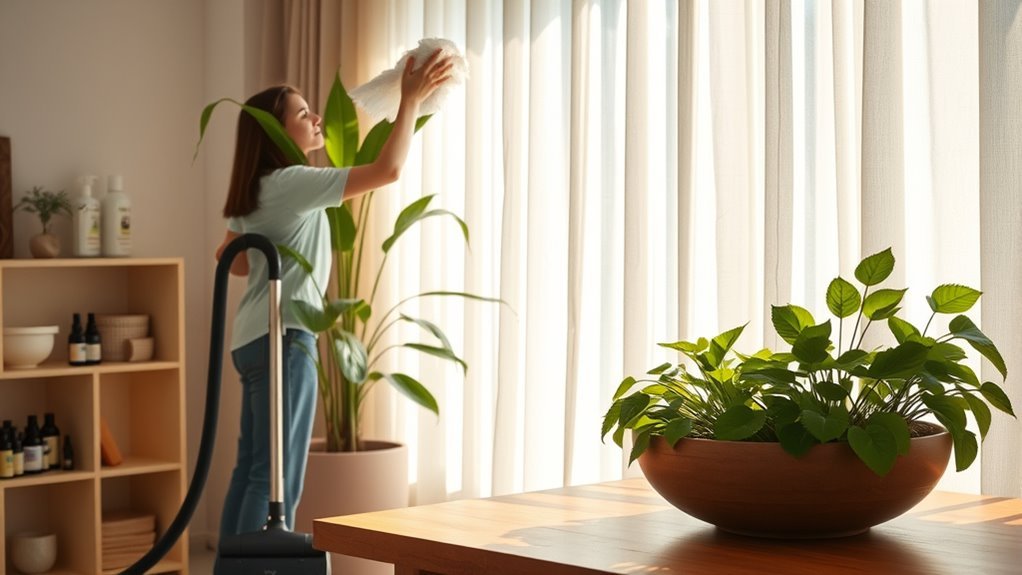How to Clean Your Home to Reduce Indoor Air Pollution
To reduce indoor air pollution, start by regularly dusting with microfiber cloths and vacuuming using a HEPA-filter vacuum to trap allergens. Control humidity between 30-50% with dehumidifiers to prevent mold, and fix leaks promptly. Choose non-toxic, low-VOC cleaning products to improve air quality. Use high-efficiency filters in your HVAC system and air purifiers to capture tiny particles. Ventilate your home well by opening windows and using exhaust fans. Keep these habits up, and you’ll discover even more ways to breathe easier indoors.
Identify Common Sources of Indoor Air Pollution

Although indoor air pollution isn’t always visible, it can come from many everyday items and activities in your home. You might not realize that asbestos exposure can still be a risk if your house was built before the 1980s, especially during renovations. Chemical pollutants also lurk in common products like cleaning supplies, paints, and even some furniture. These invisible threats limit your freedom by compromising the air you breathe daily. To reclaim control, start by identifying these hidden sources. Knowing where they originate empowers you to take action and protect your space. By recognizing asbestos and chemical pollutants, you’re one step closer to creating a healthier, freer environment where you can truly breathe easy. Don’t let unseen dangers hold you back.
Use High-Efficiency Air Filters and Purifiers
Once you’ve pinpointed the sources of indoor air pollution, the next step is to improve the air quality in your home directly. One of the most effective ways is by using high-efficiency air filters and purifiers. These devices trap even the smallest airborne particles, dramatically boosting filter efficiency and clearing pollutants that otherwise linger. When choosing filters, look for those rated with a high MERV or HEPA standard to guarantee maximum pollutant removal. Air purifiers equipped with activated carbon can also neutralize odors and chemical vapors. By investing in these tools, you take control of your environment, creating a cleaner, freer space to breathe deeply and live fully. Don’t settle for stale air—upgrade your home’s air quality and reclaim your freedom indoors.
Regularly Dust and Vacuum to Remove Allergens

Regularly dusting and vacuuming is essential to keep allergens like dust mites, pet dander, and pollen from accumulating in your home. To maximize your efforts, use effective dusting techniques such as microfiber cloths that trap particles instead of spreading them around. Don’t forget to dust hard-to-reach areas where allergens settle. When it comes to vacuum types, choose one with a HEPA filter to capture fine particles and prevent them from recirculating into the air. Upright or canister vacuums with strong suction and sealed systems work best. By staying consistent with these habits, you’ll create a fresher, freer living space with less indoor air pollution, helping you breathe easier and enjoy your home without restrictions.
Control Humidity to Prevent Mold Growth
Since excess moisture encourages mold growth, controlling humidity in your home is essential for maintaining good indoor air quality. By managing humidity levels, you take charge of mold prevention, creating a healthier space where you feel free and comfortable. Use dehumidifiers, fix leaks promptly, and ventilate well to keep moisture in check.
| Tool/Method | Purpose | Ideal Humidity Level |
|---|---|---|
| Dehumidifier | Removes excess moisture | 30-50% |
| Ventilation Fans | Circulates air | N/A |
| Fix Leaks | Stops water sources | N/A |
| Air Conditioners | Controls temperature and humidity | 30-50% |
| Moisture Meters | Measure humidity | N/A |
Keep humidity between 30-50% for effective humidity control and mold prevention.
Choose Non-Toxic and Low-VOC Cleaning Products

Why settle for cleaning products that might harm your indoor air quality? You can choose non-toxic and low-VOC cleaning products to protect your freedom to breathe fresh, clean air. Opting for eco friendly options isn’t just good for the planet—it’s vital for your home’s chemical safety. Here’s how to make smarter choices:
Choose non-toxic, low-VOC cleaning products to protect your indoor air quality and chemical safety.
- Look for labels that say “non-toxic” and “low-VOC.”
- Choose biodegradable, plant-based ingredients over harsh chemicals.
- Avoid products with synthetic fragrances or ammonia.
- Test new products in small areas to verify they don’t irritate your nose or skin.
Improve Ventilation by Opening Windows and Using Exhaust Fans
Choosing safer cleaning products is a great step, but without proper airflow, indoor pollutants can still build up. To truly free your home’s air, embrace natural ventilation by opening windows whenever possible. This simple act allows fresh air to circulate, pushing out stale, contaminated air. You don’t have to be stuck indoors breathing recycled pollutants. Pair this with exhaust fans in kitchens and bathrooms to boost exhaust efficiency. These fans pull moisture, odors, and airborne particles out, preventing them from lingering. Remember, relying solely on closed spaces traps toxins inside. By combining natural ventilation with well-maintained exhaust fans, you create an environment where fresh air flows freely, giving you control over your indoor air quality and the freedom to breathe easy every day.
Maintain and Clean HVAC Systems Frequently
Though opening windows helps, your HVAC system plays a crucial role in maintaining indoor air quality. To keep your home’s air fresh and free from pollutants, regular system maintenance is key. Don’t let dust and allergens build up; stay proactive with these steps:
- Schedule professional HVAC system maintenance at least once a year.
- Replace air filters every 1-3 months, depending on usage and filter type.
- Clean vents and ducts to prevent dust accumulation and improve airflow.
- Inspect and repair any leaks or damage promptly to avoid contamination.
Implement Pet Care Practices to Reduce Dander
If you have pets, keeping their dander under control is key to cleaner air. Regular grooming, using air purifiers, and washing their bedding often can make a big difference. These simple steps help reduce allergens and keep your indoor air fresher.
Regular Pet Grooming
While pet dander is a natural byproduct of your furry friend’s skin and fur, regular grooming can markedly cut down on the amount that gets into your home’s air. By mastering effective grooming techniques, you not only keep your pet comfortable but also reduce triggers for pet allergies, allowing everyone more freedom to breathe easy.
Here’s how to keep dander under control with grooming:
- Brush your pet daily to remove loose fur and skin flakes.
- Bathe your pet weekly using hypoallergenic shampoos.
- Trim nails and clean ears to prevent additional allergens.
- Use grooming tools designed to capture dander instead of spreading it around.
Consistent care means less dander floating freely, helping you maintain a cleaner, fresher living space.
Use Air Purifiers
Because pet dander can linger in the air even after grooming, using air purifiers is a smart way to keep your indoor environment clean. Choosing the right air purifier types and knowing their ideal placement helps you breathe easier and feel free in your own space. Here’s a quick guide:
| Air Purifier Types | Ideal Placement |
|---|---|
| HEPA Filters | Living room, bedroom |
| Activated Carbon | Near pet areas, kitchen |
| Ionic Purifiers | Small rooms, offices |
| UV Light Purifiers | Bathrooms, basements |
Position purifiers where dander accumulates most. Avoid corners and blocked airflow. This simple step complements grooming and keeps your home fresh, letting you enjoy freedom from indoor air pollution.
Frequent Bedding Cleaning
Bedding is a common hotspot for pet dander, so cleaning it often is key to reducing indoor allergens. You’ll want to focus on the bedding materials since some fabrics hold onto dander more than others. To keep your space fresh and breathe easier, consider these tips:
- Wash bedding materials weekly to cut down on dander buildup.
- Choose washable covers for pillows and mattresses to make cleaning easier.
- Use hot water cycles to effectively remove allergens.
- Dry bedding completely to prevent mold and mildew growth.
Frequently Asked Questions
How Often Should I Deep Clean Carpets to Reduce Indoor Air Pollution?
Imagine your carpet as a sponge soaking up invisible dust and allergens every day. For ideal carpet maintenance, you should deep clean it at least once every 6 to 12 months. This cleaning frequency helps prevent buildup that can choke your indoor air quality. Sticking to this schedule lets you breathe easier and keeps your home feeling fresh, giving you the freedom to enjoy a healthy, clean space without constant worry.
Can Houseplants Help Improve Indoor Air Quality Effectively?
You might wonder if houseplants benefits really extend to improving air quality. While they do help by absorbing some toxins and releasing oxygen, their impact is generally modest in a typical home. You shouldn’t rely solely on plants to clear the air but think of them as a natural boost that complements good ventilation and cleaning. Adding a few houseplants can create a fresher vibe, giving you more freedom to enjoy your space.
What Are the Best Times of Day to Ventilate My Home?
The best times for ideal ventilation depend on seasonal changes. In spring and fall, when outdoor air is fresh and mild, you’ll want to open windows in the early morning and late evening to let cool air flow through. During summer, ventilate early mornings or late nights to avoid hot, polluted air. In winter, ventilate midday when it’s warmest outside, but keep it brief to maintain comfort. You’ve got the freedom to choose what fits your lifestyle!
How Do Scented Candles Affect Indoor Air Pollution?
Scented candles might seem like a simple way to freshen your space, but they can actually increase indoor pollution. When you burn them, they release tiny particles and chemicals that can affect your air quality. If you want to enjoy a pleasant scent without compromising freedom from indoor pollution, consider using natural alternatives like essential oil diffusers or beeswax candles. That way, you’re in control of what you breathe.
Are Air Purifiers Safe for Children and Pets?
Imagine a gentle breeze flowing through your living room, carrying fresh, clean air that everyone breathes easily. Air purifiers offer great benefits by filtering out allergens and pollutants, making your home safer for kids and pets. Most models are designed with child safety in mind, featuring secure covers and quiet operation. Just pick one with a true HEPA filter, and you’re free to enjoy cleaner air without worrying about your little ones or furry friends.






